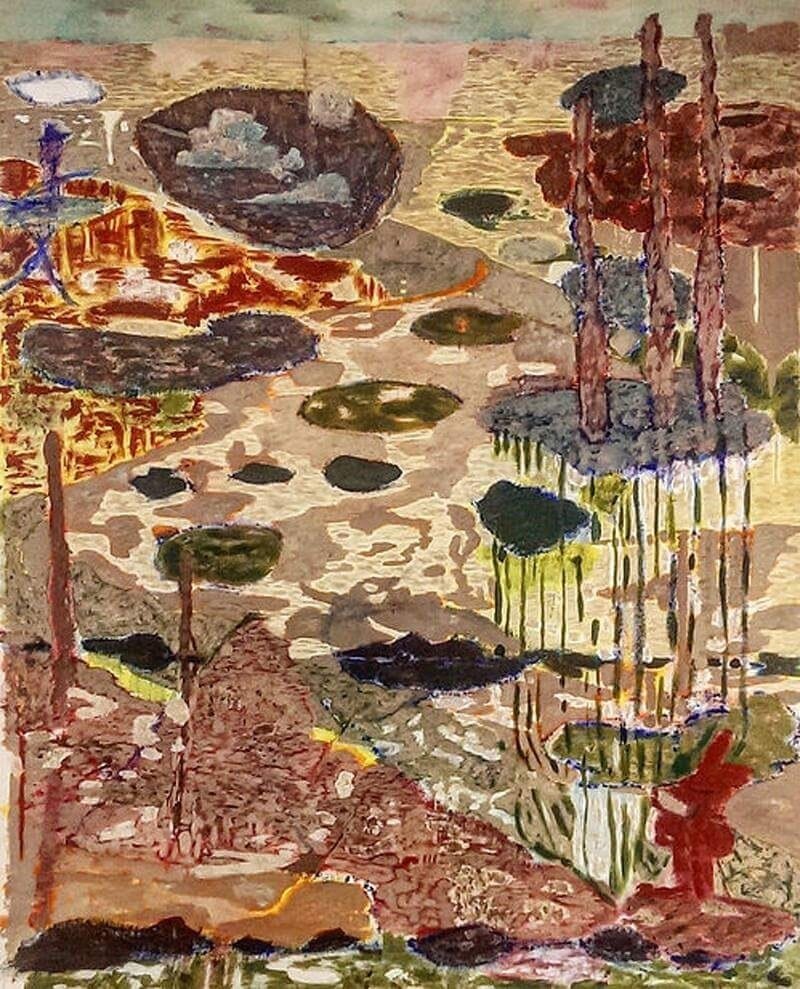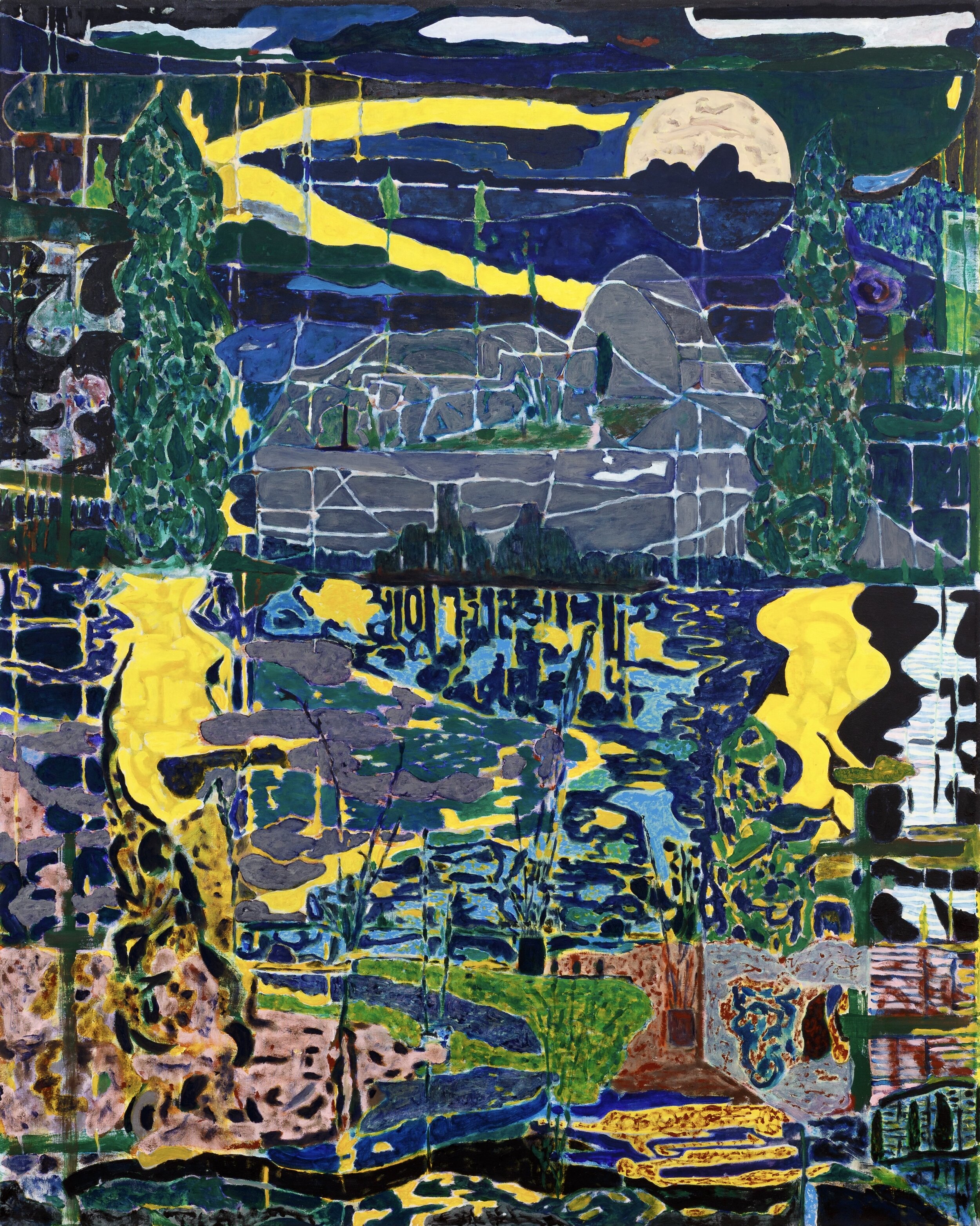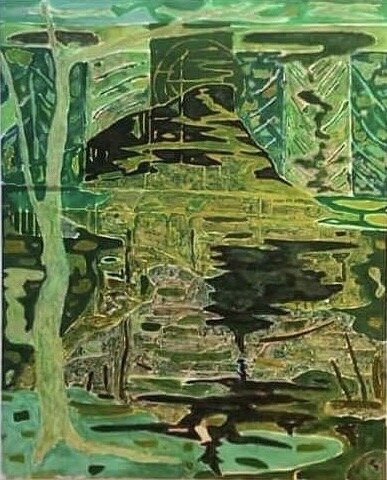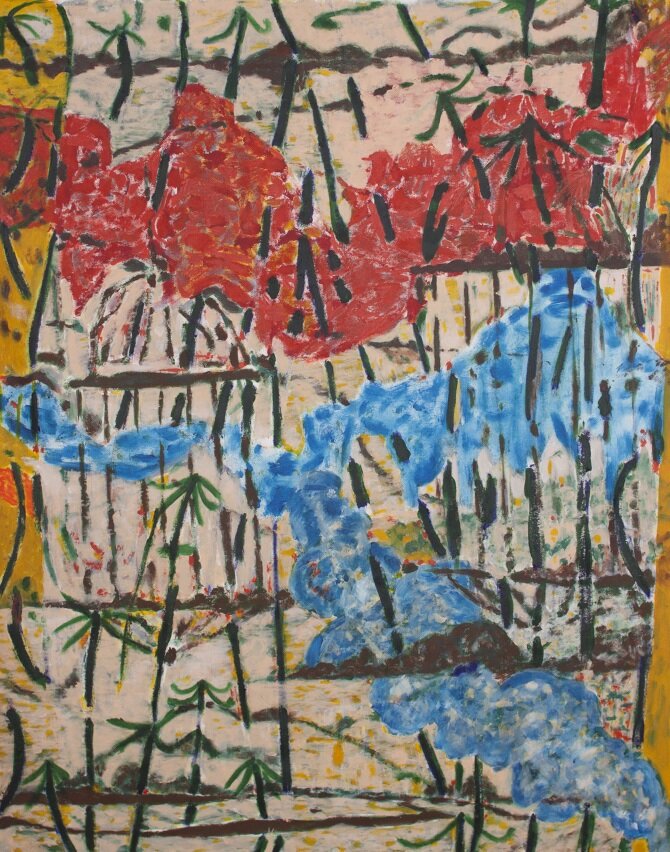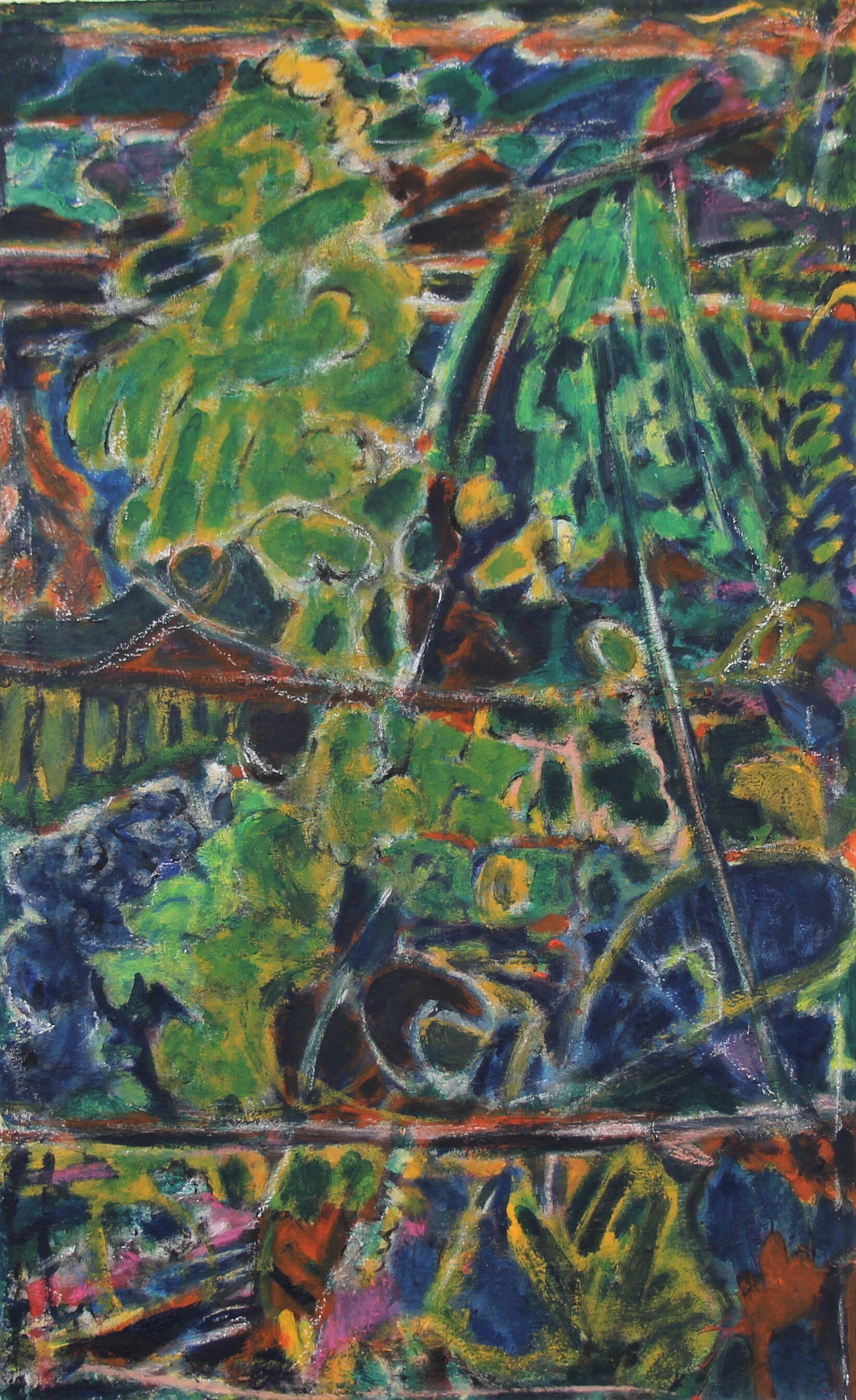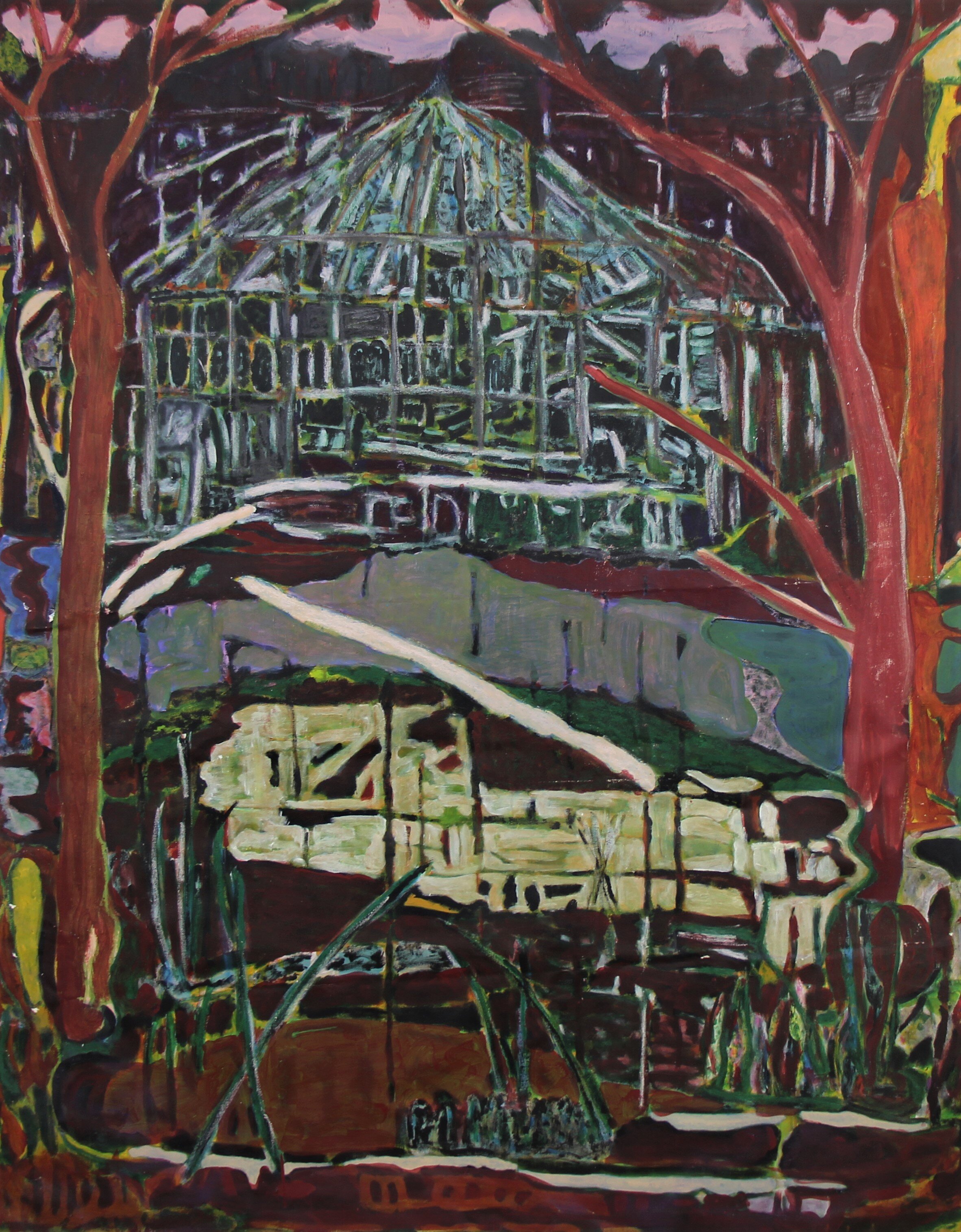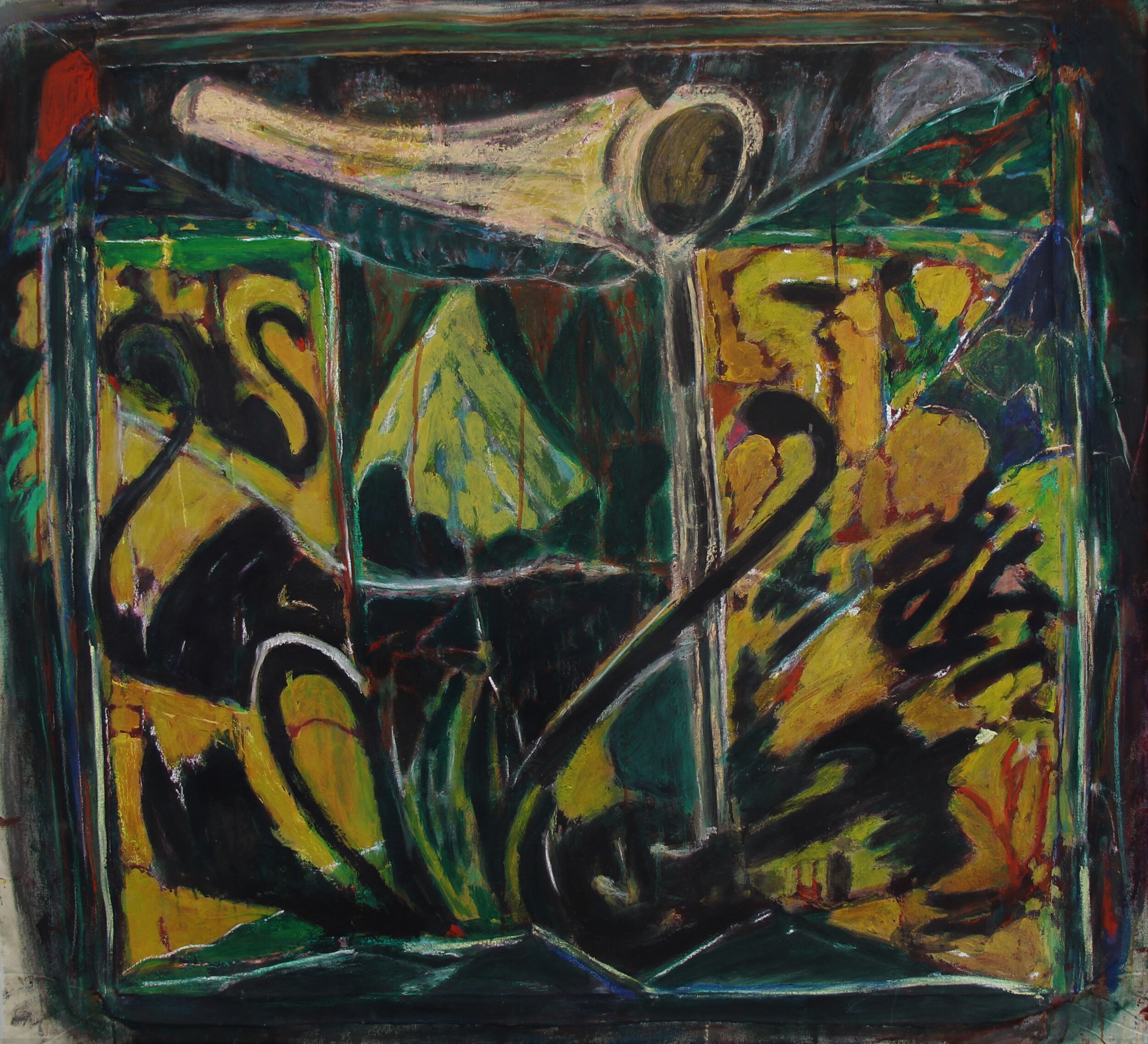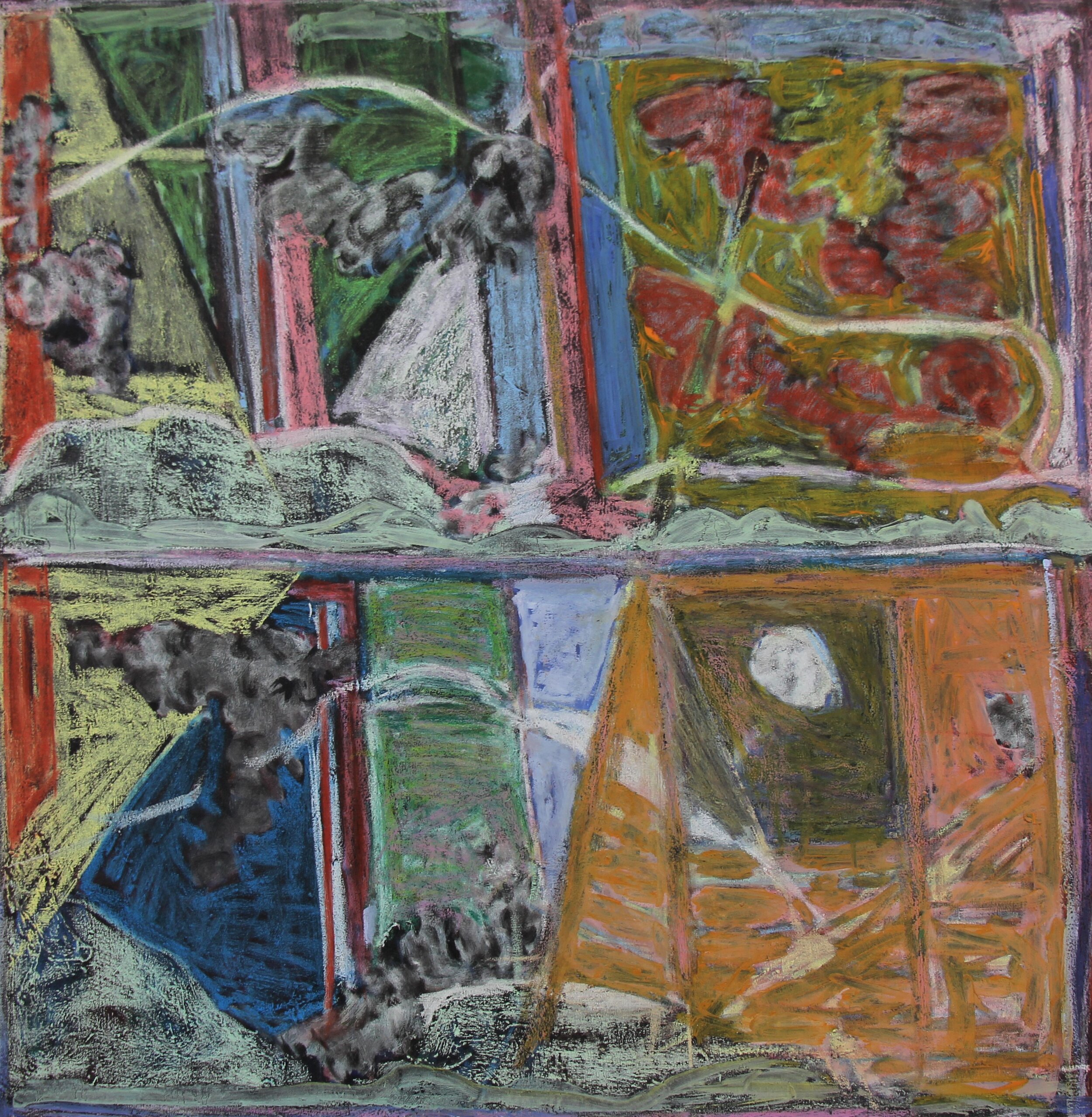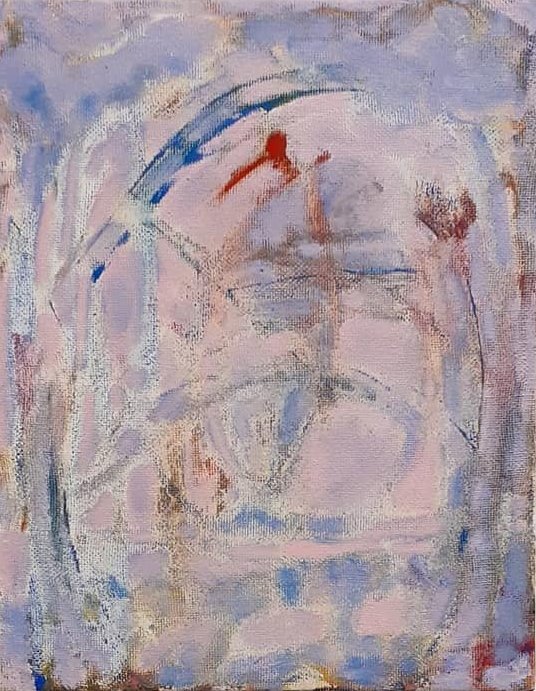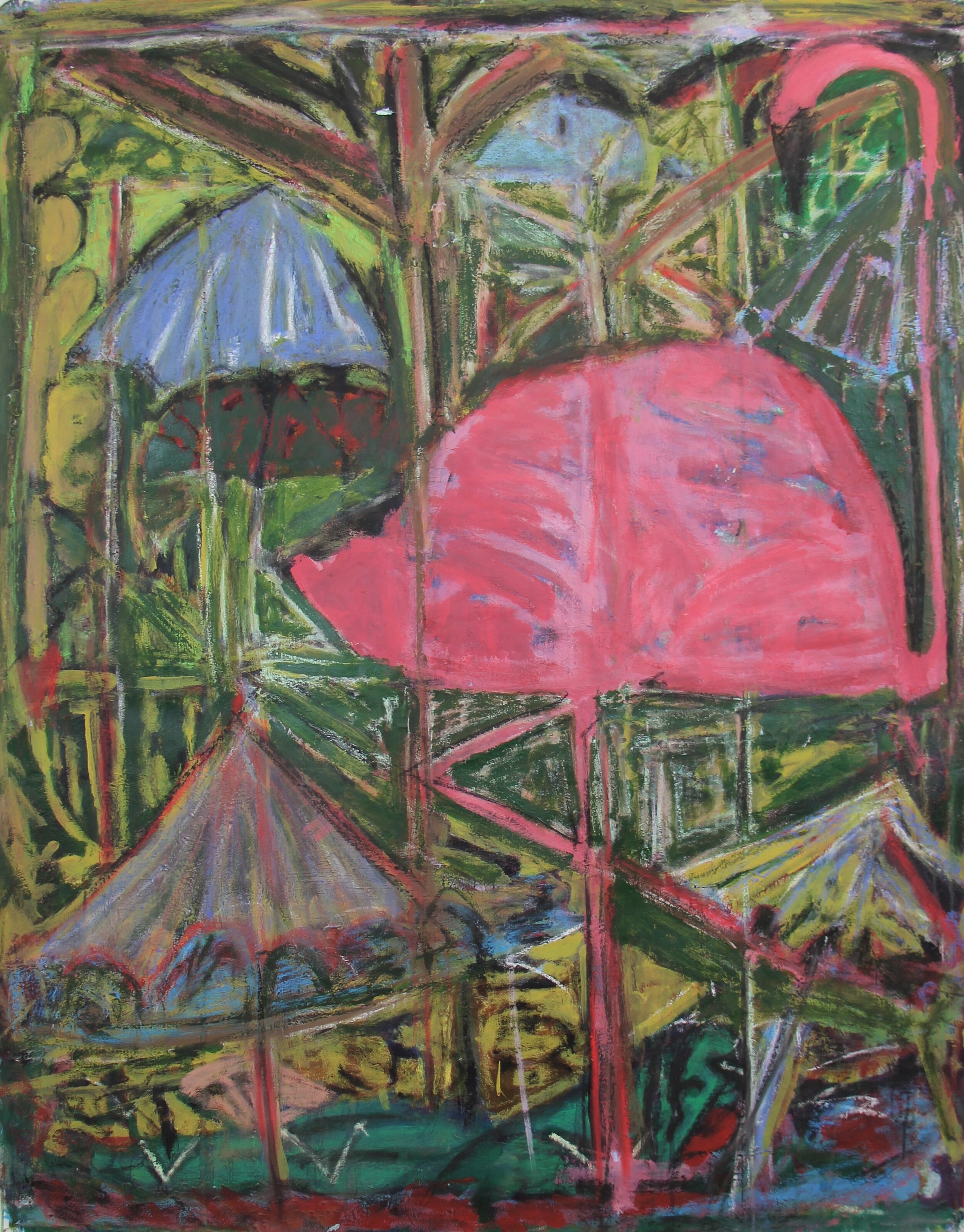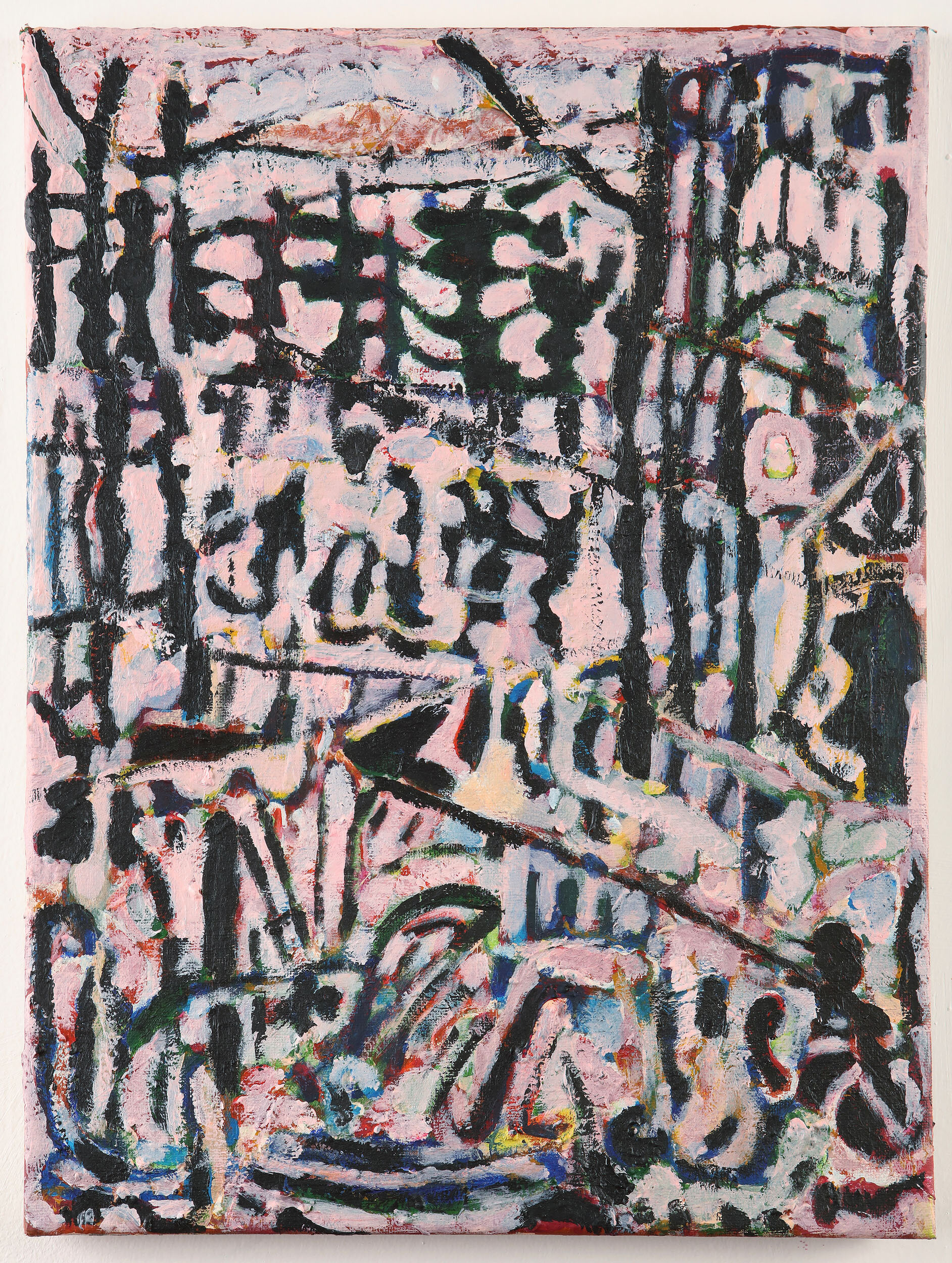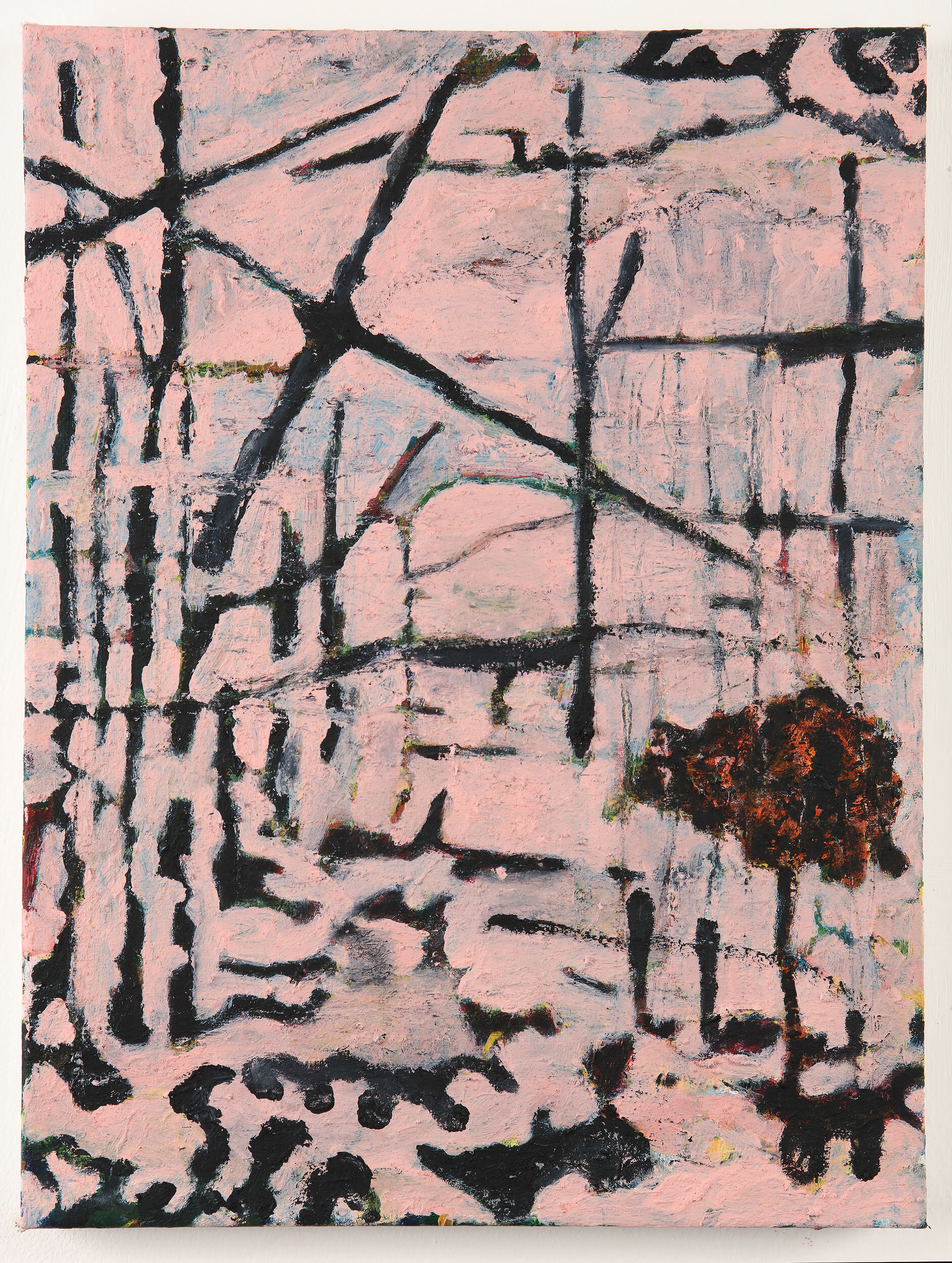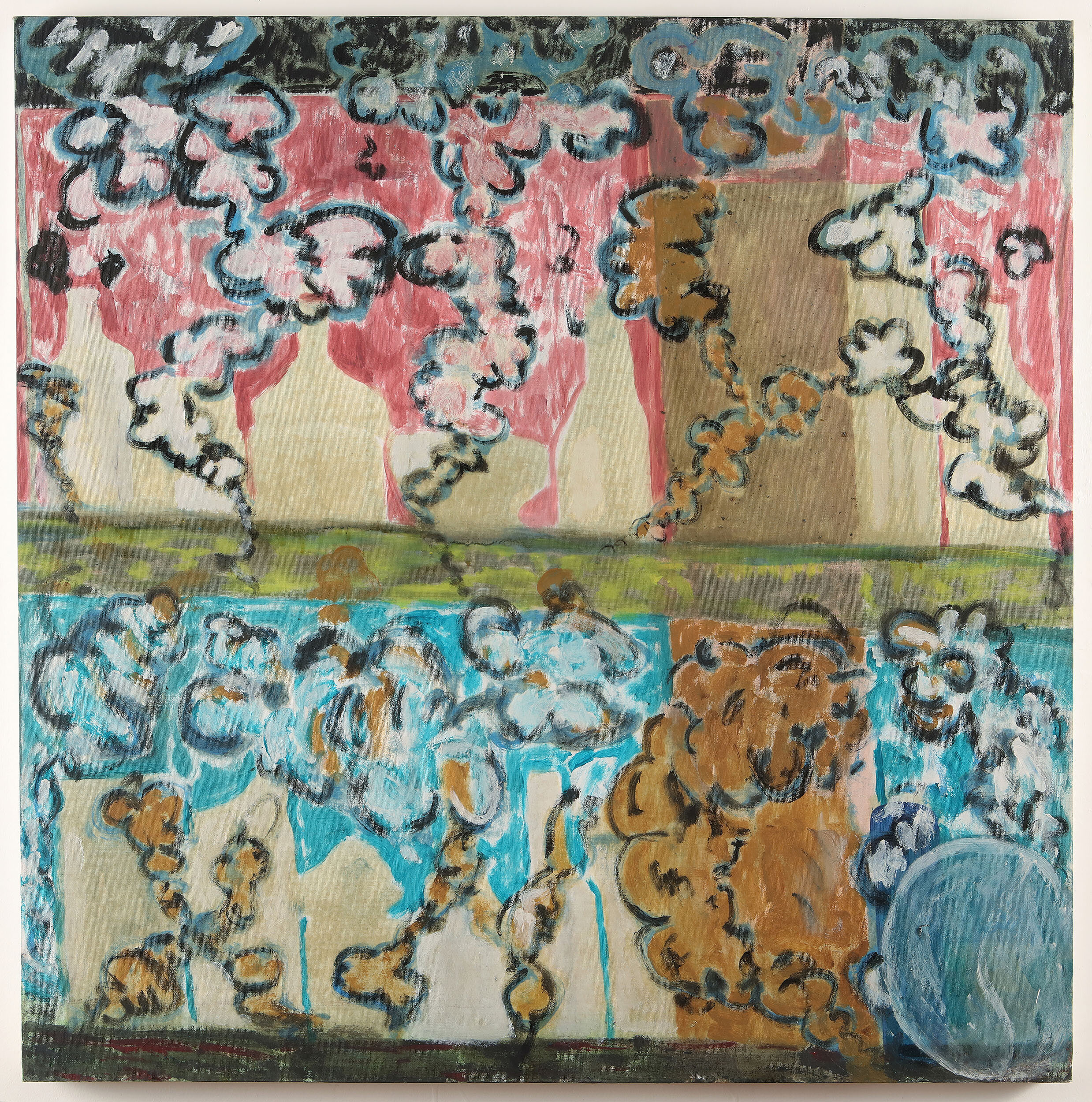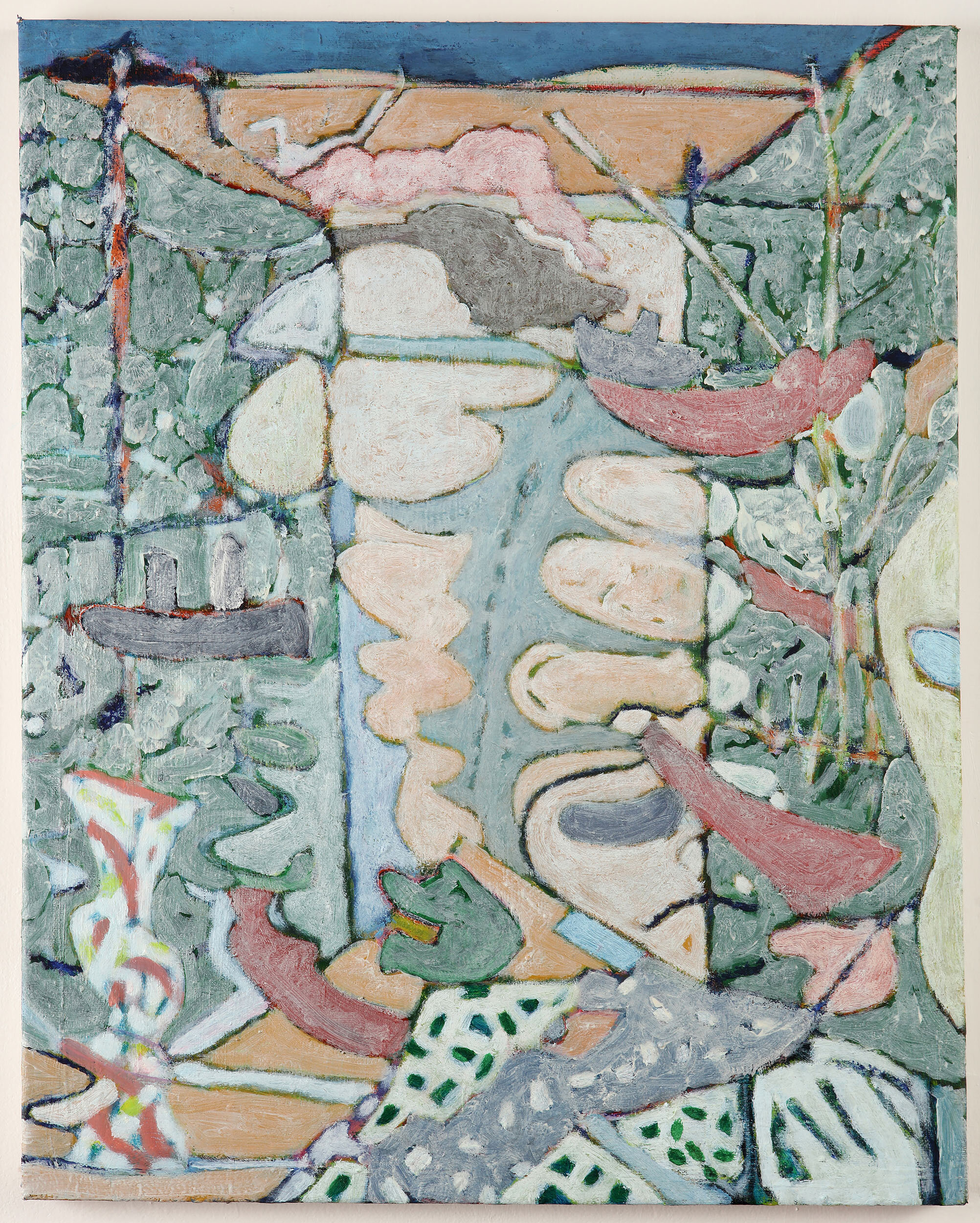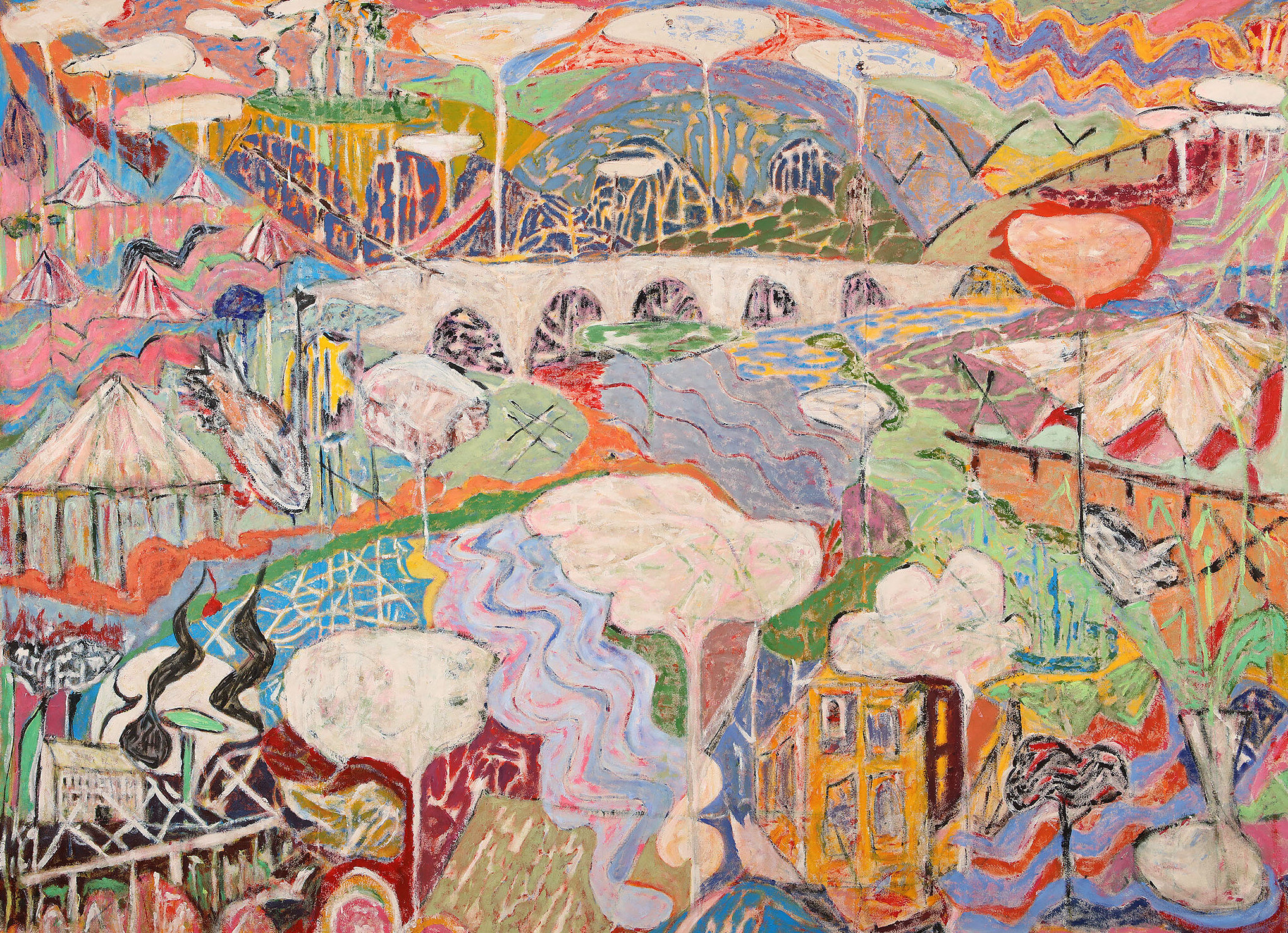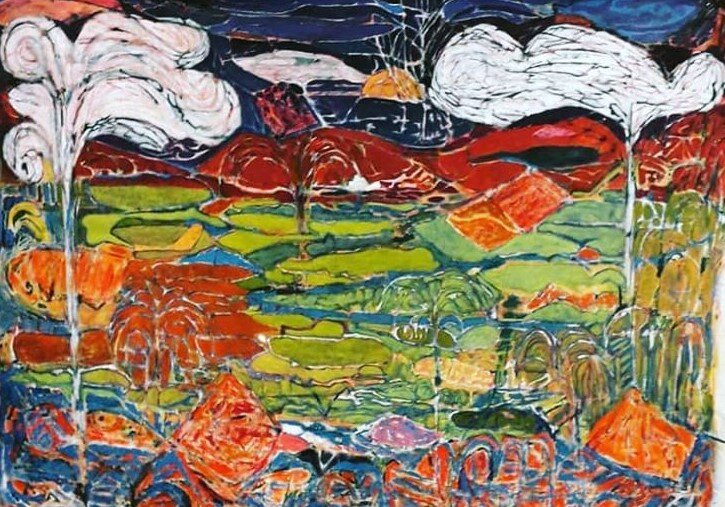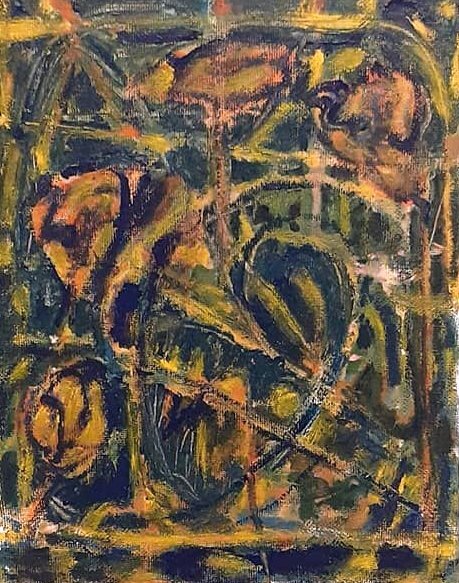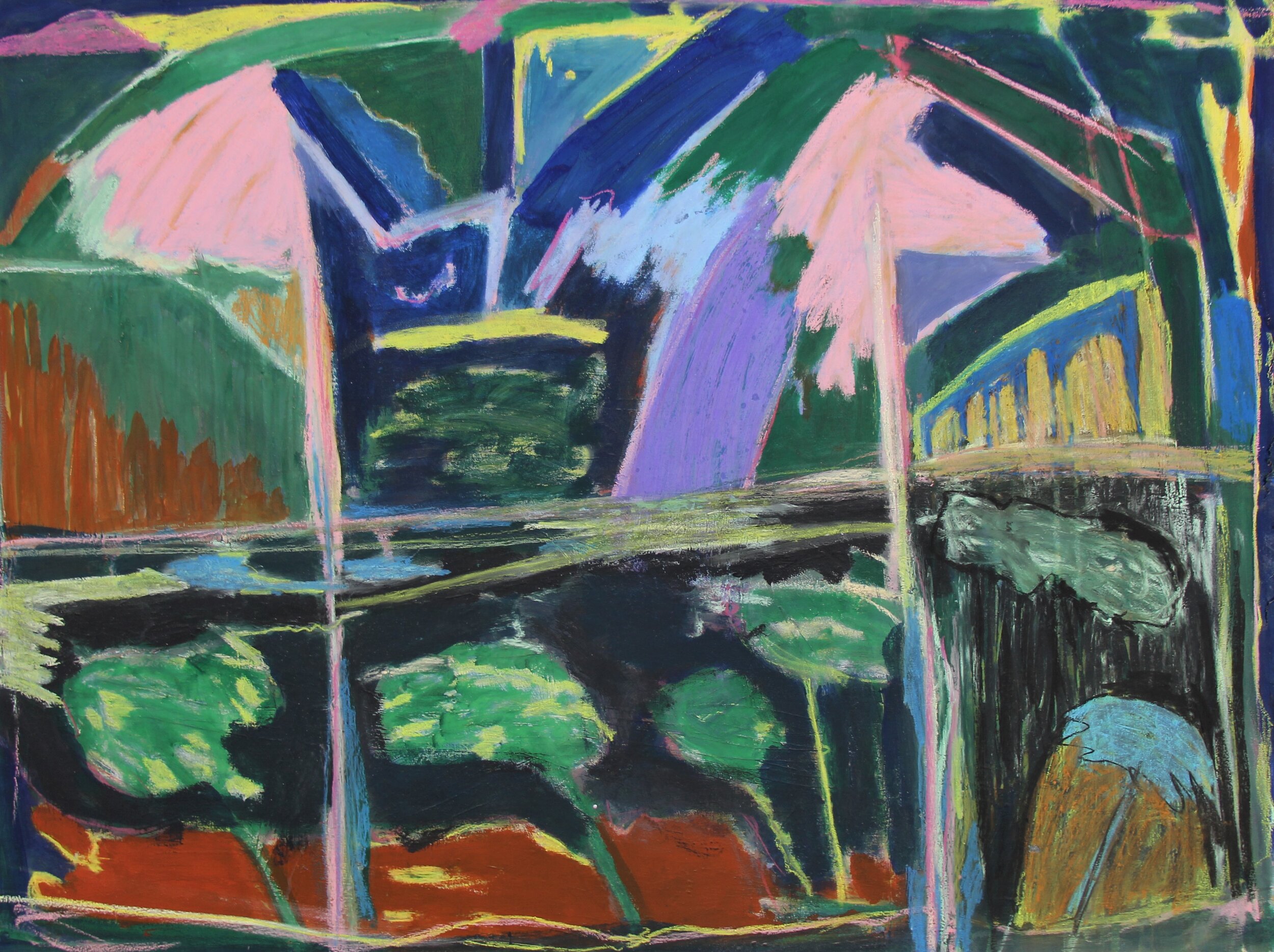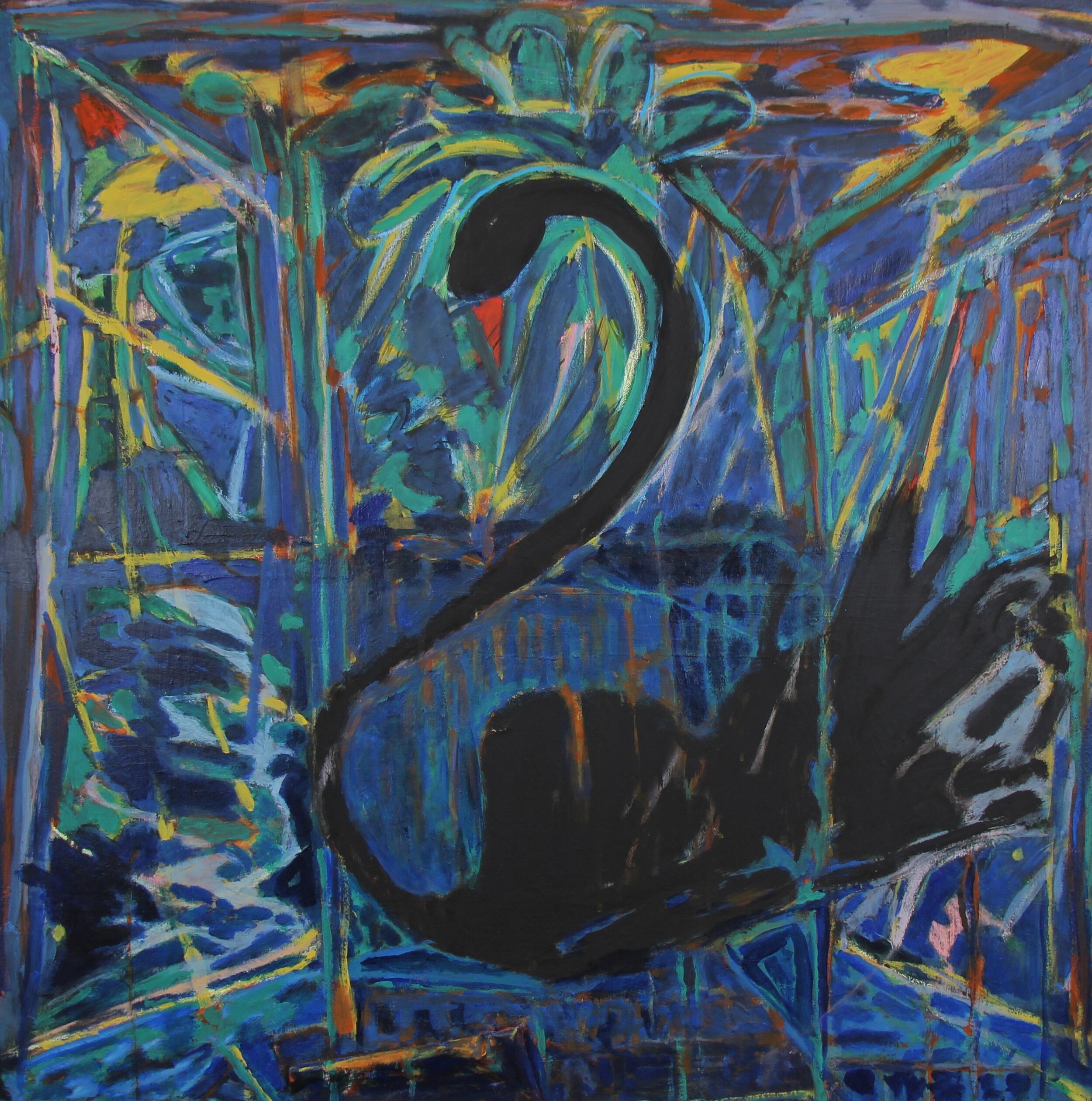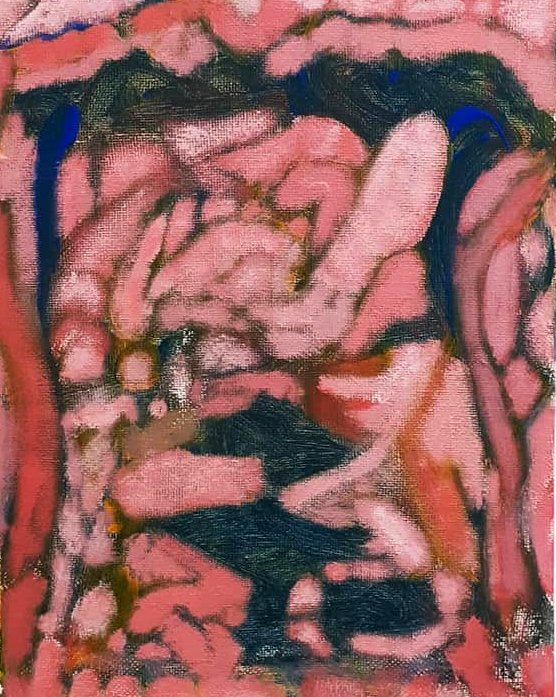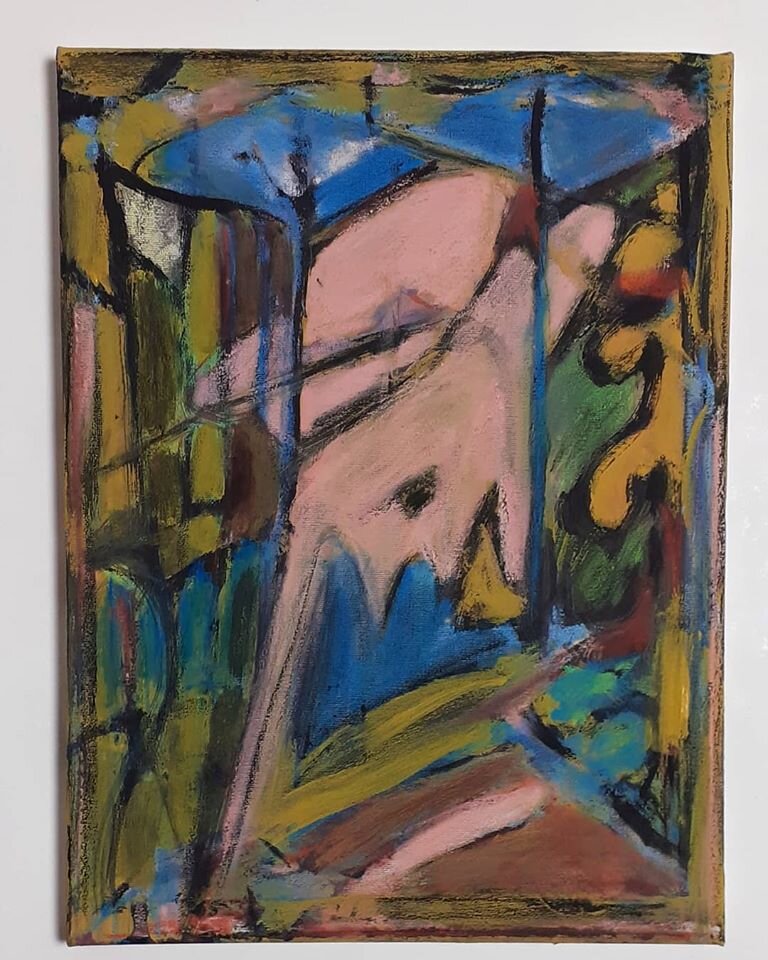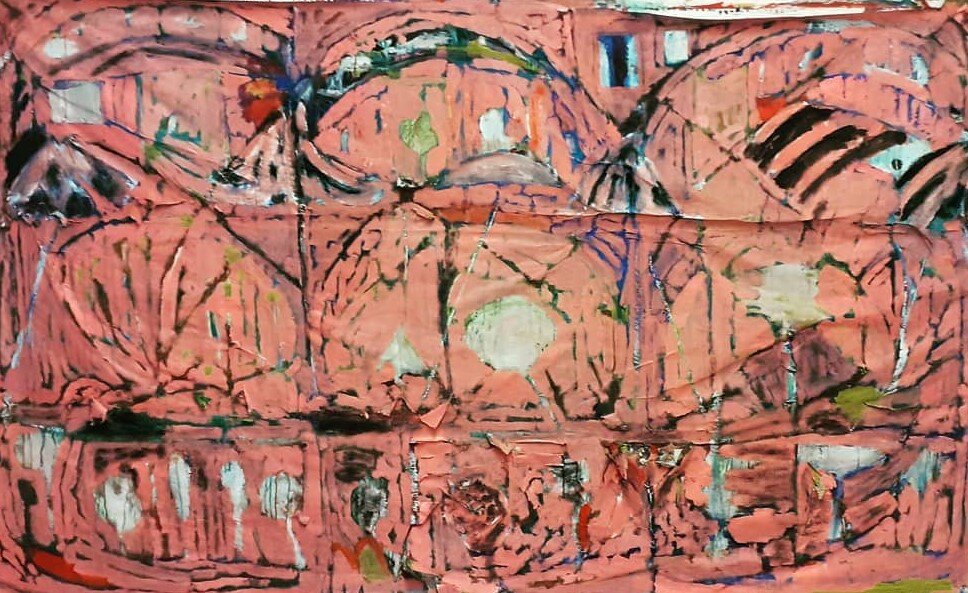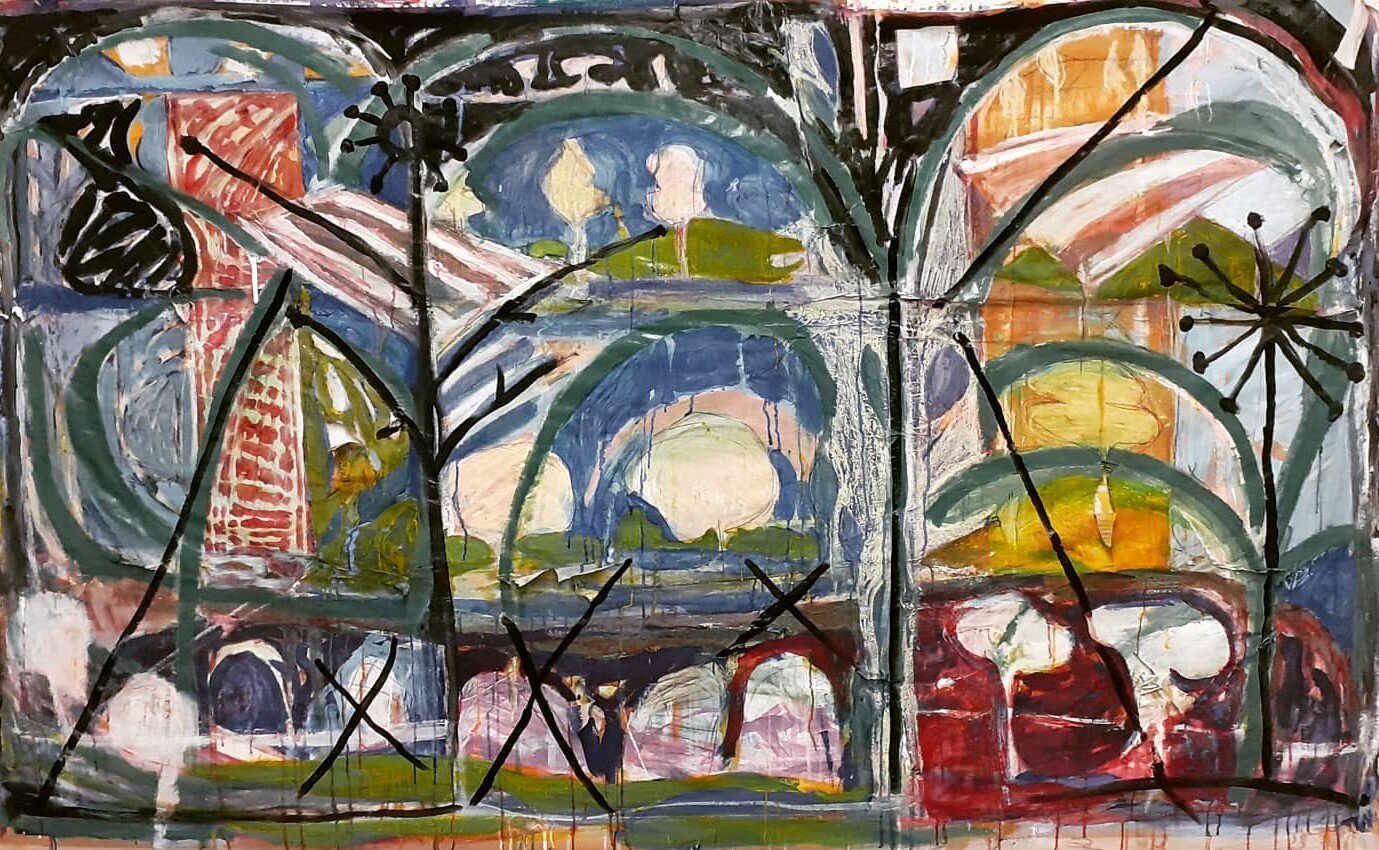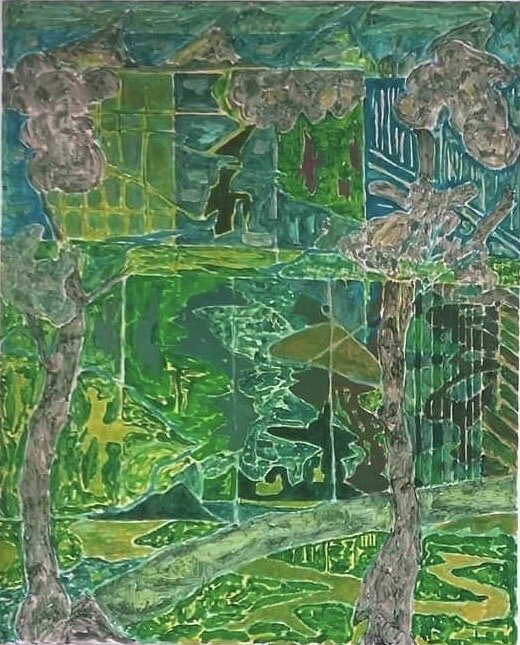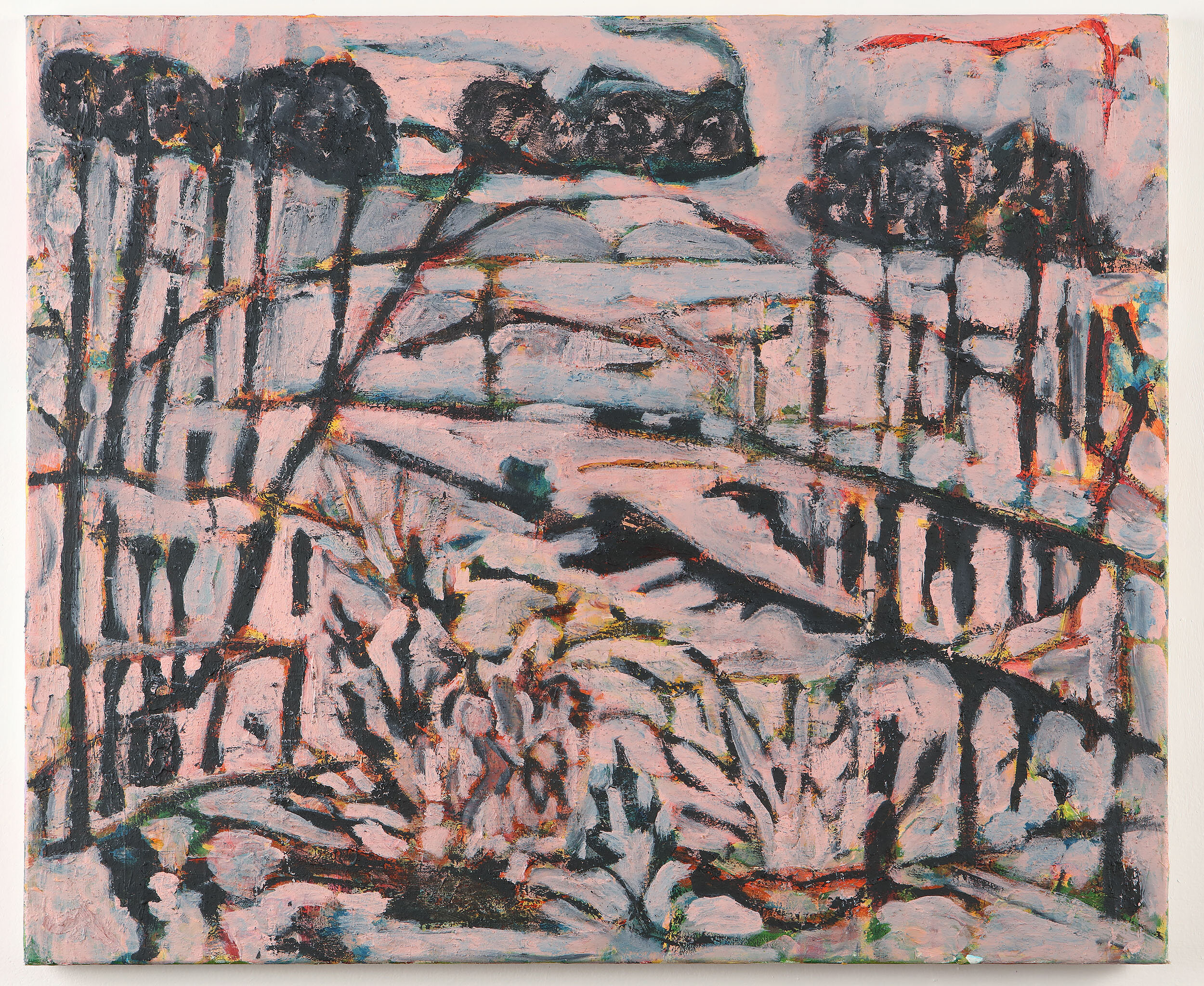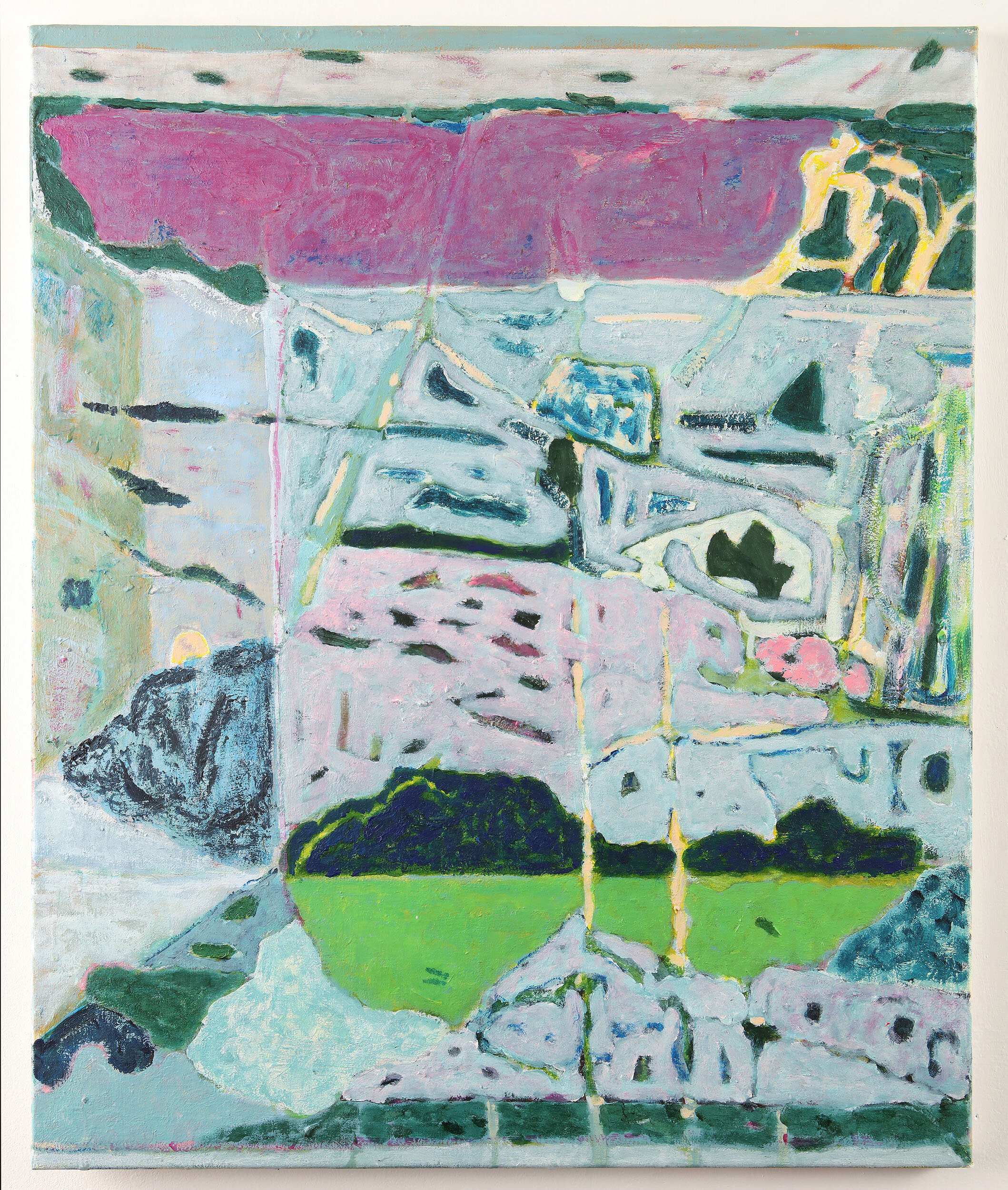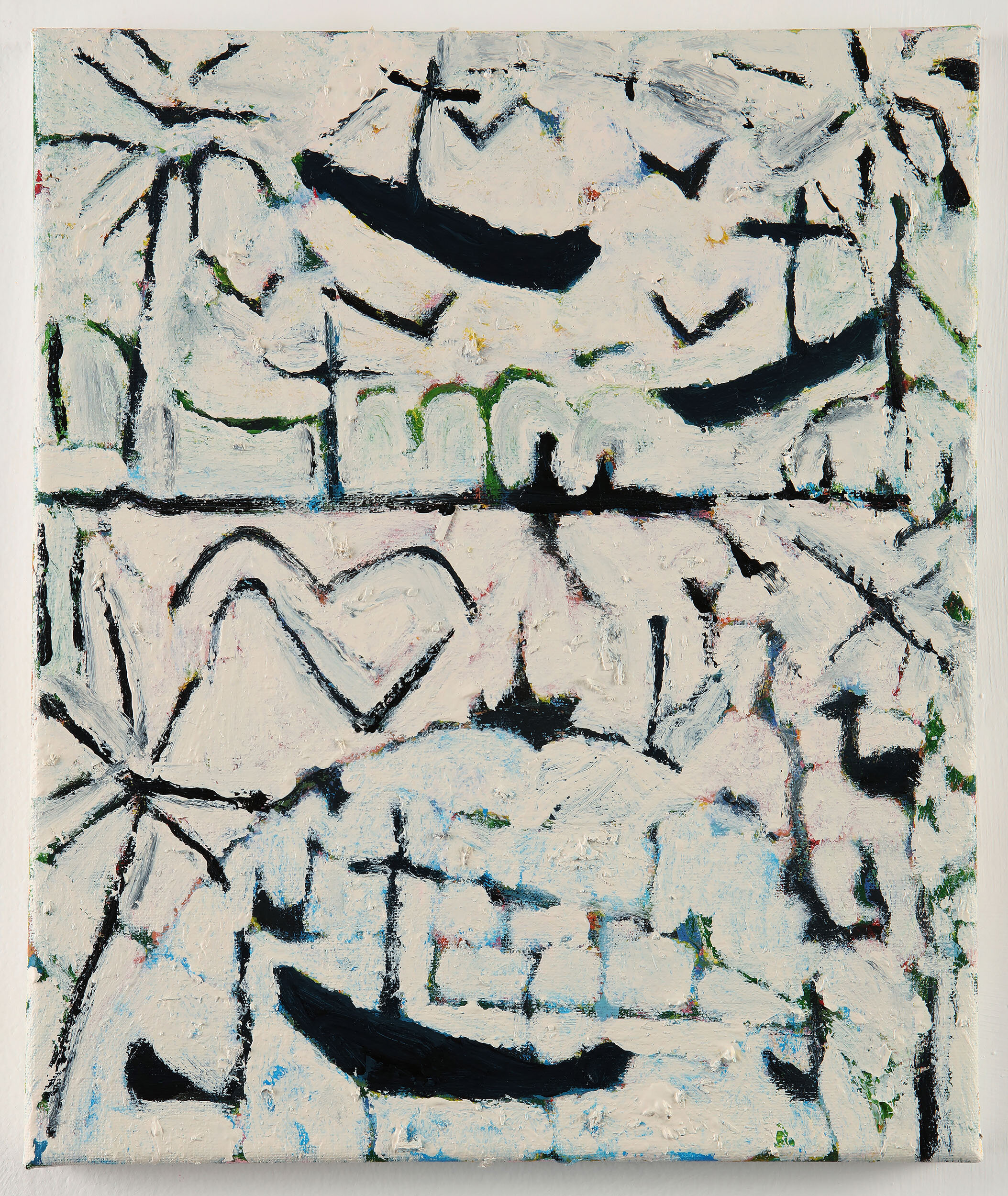Please click on the gallery above to scroll through the paintings
Gordon Dalton ‘Birdcage Blues’ - July 2020
Painting
We are delighted to collaborate with Aleph Contemporary on ‘Birdcage Blues’, a touring, virtual, solo show of recent work by GORDON DALTON.
Originally hosted and curated by Aleph Contemporary, London UK.
The work will tour, online, generating a series of fresh critical texts.
Dalton. Future Islands. 150 x 120cm, acrylic on canvas, 2017
Please visit the interpretation of this exhibition at Aleph Contemporary in their virtual gallery by clicking the link at the end of the exhibition:
L'exposition originale est organisée par l'Aleph Contemporary Veuillez consulter l'interprétation de cette exposition dans leur galerie virtuelle en cliquant sur le lien à la fin de l'exposition :
https://alephcontemporary.com/exhibitions/17-gordon-dalton-birdhouse-blues-solo-show/video/
We hope you enjoy this new collaborative process.
Nous espérons que vous apprécierez ce nouveau processus de collaboration.
Gordon Dalton
‘Birdcage Blues ’
Essay by Sally Annett June 2020
Impressions of the 21st century.
Gordon Dalton’s work demonstrates a deep understanding of the history of painting as well as a profound love of the medium. He does not just apply paint to a surface, he immerses himself into it, into its physical, visceral form. He knows what he is working with materially, intellectually and intimately. He also does more than merely nod to its context in the real world, but he begins with a process of excavation which starts in his imagination and accrues his life memories and experiences as it builds.
Dalton. ‘Flamingo Land’, 150 x 120cm, Acrylic and pastel on canvas, 2020
The elements of his world include the mundane and familiar (which may not be the same), the meta-worlds of imagination we all contain inside us and which spill out and into the realms of ‘other people’ in very many ways. In very many languages.
Dalton expresses his understanding of the world around us and contemplation of it. He is also a keen angler, and thus is able to study fauna, flora and landscape for hours at a time. The process of fishing allows consideration, absorption as well as directly feeling the environ, drink it in through the skin, smell, touch it, tastes it, sense its temperatures and feel its temporal rhythms as well as viewing it through the eyes. In this way the angler becomes part of the homeostatic process and history of the place.
Living in the north of England, this means in all weathers! Dalton is analytical about his sources inspiration yet has surprised himself. He writes;
“Fishing is an escape from everything for me. Painting is similar but it isn’t divorced from the world around me…Since moving back to Teesside, I've started fishing for the first time in 30 plus years. All these imagined places in my work and it was there in front of me all the time. When I'm fishing, I'm doing that, in the moment, which is similar to painting, just smellier! But yes, the influence is growing as I visit more lakes. Some kind of inner peace in a crazy world”.
Above Images : Birdhouse Blues, Bivvy, Ride On, Flammingo Land
Dalton produces imaginary and fantastical landscapes as seen from a distance, the ones which you look at, or out across at and that always seem to have a heightened multiplicity of patterns, interconnectivities, colours and textures. The pastoral illusion of softness which landscape creates when viewed from afar; the plump trees and patchworks of fields and woodland giving the impression that they are a mélange of fabrics, sewn together, feltlike strips of hedges and pools and ribbons of water which meander… when in reality, a walker in that landscape will have the experience of grasses and thorns. These at best tickle, but can cut and scratch, the hedges, spikey and restrictive often contain wire, invisible divisions and boundaries. The movement rather than fluid and easy can be hot, thirsty, heavy and tiring. Making paths through it would splinter your feet and slice skin like paper cut or tear your legs if you try to walk through them a novice. Within them are concealed many things which bite and sting, as well as those of great speed, beauty and gentleness. Birds are a part of this landscape, especially water birds. All concealed in an overview of beauty. It is a glorious wish, a fantastic vista and so contains within both lies and hopes.
Dalton ‘Life is Hard that's why no one survives’ Oil on canvas. 2019
The works also hold a subtle remembrance of artists and artistic eras. The vernaculars of painting are both useful and intimate devices and create a visual grammar for the artist and the viewer alike.
Paintings are screens; they are the proto-type of the digital ‘screens’, which we all carry with us today. Paintings in this context become devotional acts and offer one of the few opportunities in society, for persons to sit and contemplate, outside of the parameters of a religious setting. In times of Iconoclasm, landscape painting is particularly important. And in an era of ever moving screens, static images have particular importance and rarity. They have an unsettling romance that has been absent from some of the dialogue about ‘traditional/dying/dead forms of art and language’ for a while.
‘Future Islands.’ 2017, does this expertly, it engages as a colourist methodology, using a muted palette which combines largely secondary and tertiary colours, it plays with perspectives, on one level employing a cartographic or map-like ariel view, which has the feel of Japanese traditional landscape painting (referenced in Berland’s essay about the works in this series) which, blurs this perspective; the conventional stereoscopic view and then adds a third, three dimensional, interior area in the right hand lower section of the work. Here tree roots emerge down from a floating island and then become a cage-like structure, which weaves in and out of foreground and background. In this respect it is like Bruegel painting and yet also 16th Persian artwork. The overall effect is an expansion of the space created within the canvas. All the elements there; whether conscious or not and are incredibly beautiful. The mark making is entirely different from the three styles mentioned about, and is more like the looser impressionists, Vuillard, Bonnard, Matisse and Sickert, but with a much more southern Mediterranean palette; Goya, Velazquez, Tintoretto. There are clouds, trees, maybe buildings, under verses which mirror ‘reality’ but at all times remains a landscape painting of a river flowing through hills, creating islands, creating separation and movement.
Dalton. ‘The obutiaries showed pictires of smokestacks’, 100 x 100, acrylic on canvas 2020.
Throughout the landscapes are birds, notably swans, or allusions to birds through the metaphor of the empty cage.
Dalton writes, “The cages most directly reference a lot of zoos or local park architecture - I did a residency in Buenos Aires and there was this amazing abandoned zoo. They had popped up before in paintings, mainly as I was combining interiors and exteriors and a birdcage seemed to be both at the same time. Obviously, they can take on lots of metaphors, especially at this time, but from a practical view, the work very well compositionally, like a Bonnard window, or Francis Bacon's boxes”.
Other landscapes are brighter, ‘Life is Hard that's why no one survives’, 2019; the title seems almost misleading as it is such a joyous carnival of pinks, peaches, purples blues of oranges. Comparable palettes are perhaps South American; Amaringo, Rego and Kahlo, as well as the French pointillist Seurat. ‘The obituaries showed pictures of smokestacks’, 2020, have harder, more fauvist palettes and in places use black paint, echoes of Marc but also of German expressionism. When asked about his use of black pigment (many artists avoid it unless working in monochrome), Dalton explains “I try to avoid it but there’s a certain graphic quality. I try and build up other colours but when it’s needed its effective”. He moves between mediums, oils, acrylics and drawing materials, producing a depth and subtlety, observing that to create the darkest tones he uses,”… pastel a lot, there is certain level of drawing and redrawing. It's mostly layers of Blues and greens over Pinks and reds…”
Dalton. ‘Inside I'm thinking paradise’.150 x 120cm, acrylic on canvas, 2016
Dalton is not afraid to use graphic forms and line, vertical lines and grids repeat through the work, functioning as containment as well as repetition and mirroring. The vertical lines suggest much more movement and create energetic, spatial fields, which are multi-representational and can be reeds (echoing landscapes and spinning) or the bars of cages.
Dalton. ‘Will the night last forever?’ 150 x 120cm, acrylic on canvas, 2017
This sense of formal division, of a particular ontology or compartmentalization is a repeat motif. Even more naturalistic landscapes such as ‘Will the night last forever?’ 2017, have clear geometric divisions, based on a midline horizontal axis in the painting with approximately 120 grid squares almost hidden underneath. The blues in this work and paint marks reminiscent of early Mondrian’s and Matisse. The dark blues effectively utilize the contrasting indigoes and yellows. In ‘Can I sit next to you?”, continues this style, with more geometric shapes, triangles and rectangles which lean heavily on each other and set our visual cortex’s straining equally to find more definite form and meaning in the shapes. But the process of making marks, of paint language demands that we look for and expose the secret landscapes within ourselves, for ourselves. Dalton is sharing his internal vistas and particular boundaries, the hidden structures of the public and personal languages he explores. They are vibrant and strong, but have constraints, or deliberate (de – liberative) elements and also a softness. Works like, ‘I am so lost without you’ and the other ‘pink paintings’, are the most abstracted, and 030*, although more of a prospect, is almost palpably soft, it looks felt like, quilting or down, but this depth of creamy and downy visual text, painting is profound, comforting and seductive.
Dalton_030
Above Images : It Seems So Long Point of View, I Thought I Would Take a Final Walk, Big Dipper, Green 3.
There is little figuration in the works, the main literal forms being trees, geographical or industrial schema and the title subject; bird cages and the image of the swan. The swan and the pink flamingo have been cultural icons, since the beginning of written history, with mythical, religious, transformation and royal meanings but in Dalton’s work these ‘idols’ are synthetic and much could be read into this is a modern symbolist context.
Dalton. ‘I said something i did not mean to say’. 170 x 240, acrylic on canvas 2010
The same differentiation of sentiment is found when looking for clues in the titles of the pieces, this time with a sense of loss or absence. His green series of works; ‘It seems so long since you went away’ and ‘I thought I would take a final walk’ 2017, hint at the passing of time and the structural, geometric mirroring of the paintings are literally representing (self) reflection a sense of the solitary and if not sorrowful then melancholic. As with so many of his paintings it is the combination of all the elements, combined; colour, geometry, scale (which has a weighty affect on the response to any work), mark making which make the works so emotionally rich. This richness is nuanced, no one painting is ‘joyous’ or ‘sorrowful’, Dalton combines play and gravitas, ecstasy and introversion, the industrial and rural with a beauty and complexity which under layed by an understanding of the history of painting, honesty and compulsion to understand his environment.
It is a jewel of a show.
Sally Annett
June 2020
Above Images : Top left to bottom right,
05, 07, 025, 012
01, Elephant Graveyard, 026, 030
The Promise, The Sad Tree, Northern Theme Park, Park Lake
Too Late, Wildside, Can I Sit Next To You? Inside I’m Thinking Paradise
To go to Aleph Contemporary Virtual Gallery space click here:
Pour accéder à l'espace Aleph Contemporary Virtual Gallery, cliquez ici : https://alephcontemporary.com/exhibitions/17-gordon-dalton-birdhouse-blues-solo-show/video/
Toutes les œuvres sont en vente, veuillez nous contacter directement à l'adresse suivante si vous souhaitez acheter une pièce : annett897@btinternet.com
All works are for sale, please contact us directly at email annett897@btinternet.com, if you wish to purchase a piece.
To be read in conjunction with the essays by Rosa JH Berland and Liam O'Connor
Traduction Francais
Gordon Dalton
Le blues des cages à oiseaux
Essay par Sally Annett
Impressions du XXIe siècle.
Le travail de Gordon Dalton démontre une compréhension profonde de l'histoire de la peinture ainsi qu'un amour profond du médium. Il ne se contente pas d'appliquer de la peinture sur une surface, il s'immerge dans celle-ci, dans sa forme physique, viscérale. Il sait avec quoi il travaille matériellement, intellectuellement et intimement. Il ne se contente pas de faire un clin d'œil à son contexte dans le monde réel, mais il commence par un processus d'excavation qui commence dans son imagination et s'enrichit de ses souvenirs et de ses expériences au fur et à mesure qu'il se construit.
Les éléments de son monde comprennent les mondanités et les familiers (qui peuvent ne pas être les mêmes) ainsi que les imaginaires et les méta-mondes que nous avons tous en nous, qui se répandent dans le monde des autres de bien des façons. Dans de très nombreuses langues.
Dalton exprime sa compréhension du monde qui nous entoure et sa contemplation, il est également pêcheur, et peut ainsi étudier la faune, la flore et le paysage pendant des heures. Le processus de la pêche permet de considérer, d'absorber ainsi que de sentir directement l'environnement, de le boire à travers la peau, de le sentir, de le toucher, de le goûter, de sentir ses températures et ses rythmes temporels ainsi que de l'observer à travers l'œil. De cette façon, le pêcheur devient une partie du processus homéostatique de l'histoire du lieu où il se trouve.
Vivant dans le nord de l'Angleterre, cela signifie par tous les temps ! Dalton est analytique sur ses sources d'inspiration et pourtant il s'est surpris lui-même.
"Pour moi, la pêche est une évasion de tout. La peinture est similaire, mais elle n'est pas séparée du monde qui m'entoure... Depuis que je suis revenu à Teesside, j'ai commencé à pêcher pour la première fois depuis plus de 30 ans. Tous ces endroits imaginés dans mon travail et c'était là devant moi tout le temps. Quand je pêche, je le fais, dans l'instant, ce qui est semblable à la peinture, juste l'odeur ! Mais oui, l'influence grandit à mesure que je visite d'autres lacs. Une sorte de paix intérieure dans un monde fou".
Dalton produit des paysages imaginaires et fantastiques vus de loin, ceux que l'on regarde, ou que l'on voit de l'autre côté et qui semblent toujours présenter une multiplicité accrue de motifs, d'interconnexions, de couleurs et de textures. L'illusion pastorale de la douceur que crée le paysage vu de loin ; que les arbres touffus et les patchworks de champs et de bois donnent l'impression d'être un mélange de tissus, cousus ensemble, de bandes de haies et de bassins en feutre et de rubans d'eau qui serpentent... alors qu'en réalité un promeneur dans ce paysage, aura l'expérience des herbes. au mieux chatouille, mais peut couper et gratter, les haies, hérissées et restrictives contenant souvent du fil de fer. Le mouvement plutôt que fluide et facile peut être chaud, assoiffé, lourd et fatigant. Faire des chemins à travers elle vous ferait éclater les pieds et vous trancherait la peau comme du papier, vous couperait ou vous déchirerait les jambes si vous essayez de les traverser en tant que novice. En eux se cachent de nombreuses choses qui mordent et piquent, ainsi que celles de grande vitesse, de beauté et de douceur. Les oiseaux font partie de ce paysage, en particulier les oiseaux aquatiques. Tous cachés dans une vue d'ensemble de la beauté. C'est un souhait glorieux, une vue fantastique et il contient donc à la fois des mensonges et des espoirs.
Les œuvres contiennent également un souvenir subtil d'artistes et d'époques artistiques. Les vernaculaires de la peinture sont à la fois des dispositifs utiles et intimes et créent une grammaire visuelle pour l'artiste et le spectateur.
Les peintures sont des écrans - elles sont le prototype des "écrans" numériques, que nous portons tous avec nous aujourd'hui. Dans ce contexte, les peintures deviennent des actes de dévotion et offrent l'une des rares occasions dans la société, pour les personnes, de s'asseoir et de contempler, en dehors des paramètres d'un cadre religieux. En période d'iconoclasme, la peinture de paysage est particulièrement importante. Et à une époque où les écrans sont toujours en mouvement, les images statiques ont une importance et une rareté particulières. Elles ont une romance troublante qui a été absente pendant un certain temps de certains dialogues sur les "formes d'art et de langage traditionnelles/mortelles".
Les îles du futur. 2017 le fait de manière experte, elle s'engage comme une méthodologie coloriste, en utilisant une palette sourde qui combine largement des couleurs secondaires et tertiaires, elle joue avec les perspectives, à un niveau en employant une vue ariel cartographique ou de type carte, qui a la sensation de la peinture de paysage traditionnelle japonaise (référencée dans l'essai de Berland sur les œuvres de cette série) qui, brouille cette perspective ; la vue stéréoscopique conventionnelle et ajoute ensuite une troisième zone intérieure, en trois dimensions, dans la partie inférieure droite de l'œuvre. Ici, les racines des arbres émergent d'une île flottante et deviennent une structure en forme de cage, qui se faufile entre le premier plan et l'arrière-plan. À cet égard, c'est comme la peinture de Bruegel, mais c'est aussi une œuvre d'art persane du XVIe siècle. L'effet global est une expansion de l'espace créé dans la toile. Tous les éléments qui s'y trouvent, qu'ils soient conscients ou non, sont incroyablement beaux. Le marquage est entièrement différent des trois styles mentionnés ci-dessus et ressemble davantage aux impressionnistes plus lâches, Vuillard, Bonnard, Matisse et Sickert, mais avec une palette méditerranéenne beaucoup plus méridionale : Goya, Velazquez, Tinteretto. Il y a des nuages, des arbres, peut-être des bâtiments, sous des vers qui reflètent la "réalité" mais qui restent toujours une peinture de paysage d'une rivière coulant à travers des collines, créant des îles, créant la séparation et le mouvement.
Dans tous les paysages, il y a des oiseaux, notamment des cygnes, ou toutes les allusions aux oiseaux par la métaphore de la cage vide.
Dalton écrit : "Les cages font référence de la manière la plus directe à l'architecture des zoos ou des parcs locaux - j'ai fait une résidence à Buenos Airies et il y avait cet étonnant zoo abandonné. Elles étaient déjà apparues dans des peintures, principalement parce que je combinais des intérieurs et des extérieurs et qu'une cage à oiseaux semblait être les deux à la fois. Évidemment, ils peuvent prendre beaucoup de métaphores, surtout à cette époque, mais d'un point de vue pratique, l'œuvre est très bien composée, comme une fenêtre de Bonnard, ou les boîtes de Francis Bacon".
D'autres paysages sont plus lumineux, "Life is Hard that's why no one survives", 2019 ; le titre semble presque trompeur car il s'agit d'un joyeux carnaval de roses, de pêches, de violets, de bleus et d'oranges. Les palettes comparables sont presque les Amaringo, Rego et Kahlo d'Amérique du Sud, ainsi que Seurat. Alors que "Les nécrologies montraient des photos de cheminées", 2020 a des palettes plus dures, plus fauves et utilise par endroits de la peinture noire, écho de Marc mais aussi de l'expressionnisme allemand. Interrogé sur son utilisation du pigment noir (beaucoup d'artistes l'évitent à moins de travailler en monochrome, explique Dalton "J'essaie de l'éviter mais il y a une certaine qualité graphique. Il passe d'un médium à l'autre, huile, acrylique et pastel, produisant une profondeur et une subtilité, observant que pour créer les tons les plus sombres qu'il utilise, "... le pastel beaucoup, il y a un certain niveau de dessin et de redessin. Il s'agit surtout de couches de bleus et de verts sur des roses et des rouges..."
Dalton n'a pas peur d'utiliser des formes graphiques et des lignes, les lignes verticales et les grilles se répètent dans l'œuvre, fonctionnant comme un confinement ainsi que comme une répétition et un miroir. Les lignes verticales suggèrent beaucoup plus de mouvement et créent des champs spatiaux énergiques, qui sont multireprésentatifs et peuvent être des roseaux (faisant écho aux paysages et tournant) ou des barres de cages. Ce sentiment de division formelle, d'ontologie ou de compartimentation est un motif répétitif. Des paysages encore plus naturalistes, comme "La nuit durera-t-elle éternellement ? 2017", présentent des divisions géométriques claires, basées sur un accès horizontal à la ligne médiane du tableau, avec environ 120 carrés de grille presque cachés en dessous. Les bleus de cette œuvre et les marques de peinture rappellent ceux des premiers Mondrian et Matisse. Les bleus foncés utilisent efficacement les contrastes entre les indigo et les jaunes. L'œuvre "Can I sit beside you" poursuit ce style, avec des formes plus géométriques, des triangles et des rectangles qui s'appuient fortement les uns sur les autres et mettent notre cortex visuel à contribution de manière égale pour trouver une forme et un sens plus précis dans les formes. Mais le processus de création de marques, de langage pictural exige que nous recherchions et mettions à nu les paysages secrets avec nous-mêmes, pour nous-mêmes. Dalton partage ses perspectives internes et ses limites particulières, les structures cachées des langages public et personnel qu'il explore. Ils sont vibrants et forts, mais ont une contrainte, ou un élément délibéré (de - libérateur) et aussi une douceur. Des œuvres comme "Je suis tellement perdu sans toi" et les autres "peintures roses" sont les plus abstraites, et 030*, bien qu'il s'agisse plutôt d'une perspective, est presque palpable, on dirait qu'il est comme un matelas ou un duvet, mais cette profondeur de texte visuel crémeux et duveteux, la peinture est profonde, réconfortante et séduisante.
Il y a peu de figuration dans les œuvres, les principales formes littérales étant les arbres, le schéma géographique ou industriel et le sujet titre ; les cages d'oiseaux et l'image du cygne. Le cygne et le flamant rose sont des icônes culturelles, depuis le début de l'histoire écrite, avec des significations mythiques, religieuses, de transformation et royales, mais dans l'œuvre de Dalton, ces "idoles" sont synthétiques et on pourrait lire beaucoup de choses dans ce contexte symboliste moderne.
La même différenciation de sentiments se retrouve dans la recherche d'indices dans les titres des pièces, cette fois avec un sentiment de perte ou d'absence, "Il semble que tu sois parti depuis si longtemps" et "Je pensais faire une dernière promenade". 2017 indices du temps qui passe et le miroir géométrique structurel des peintures représentent littéralement la (auto-)réflexion, un sentiment de solitude et, si ce n'est pas douloureux, mélancolique. Et comme pour beaucoup de ses peintures, c'est la combinaison de tous les éléments, combinés ; la couleur, la géométrie, l'échelle (qui a un effet important sur la réponse à toute œuvre), le marquage qui rendent les œuvres si riches émotionnellement. Cette richesse est nuancée, aucune peinture n'est "joyeuse" ou "triste", Dalton combine le jeu et la gravité, l'extase et l'introversion, l'industriel et le rural avec une beauté et une complexité qui sont sous-tendues par une honnêteté et une contrainte à comprendre son environnement.
C'est un bijou de spectacle.
Sally Annett June
2020
À lire en parallèle avec l'essai de Rosa JH Berland pour Aleph Contemporary pour cette série d'œuvres.
BIOGRAPHY
Gordon Dalton
Dalton has earned an international reputation for his resplendently coloured paintings. He holds his MA, Fine Art, University of Northumbria, and an honours BA, Fine Art, University of Wales, Cardiff. Select residencies include URRA, Buenos Aires, Argentina, 2016 and the Chapter Art Gallery, Cardiff, 2007. Select solo exhibitions: Trade Gallery, Nottingham; Bay Art, Cardiff; Last Gallery, Llangadog; Bank Gallery, Los Angeles; Keith Talent, London; Marksman Gallery, Reading; Castle eld Gallery, Manchester; Moot Gallery, Nottingham. Select group shows: Newlyn Art Gallery, Penzance; Contemporary British Painting Prize, Riverside Gallery, Richmond; Beep Wales Painting Prize, Swansea (touring); Del In nito Art Gallery, Buenos Aires; City Limits, Oriel Canfas, Cardiff; National Eisteddfod of Wales, Abergavenny; Exeter Contemporary Open, 2015, Exeter Phoenix; Bankley Gallery & Studios, Manchester; Transition, London; Syson, Nottingham; Elysium Gallery, Swansea; Bank Art, Los Angeles; Galerie Skuc, Ljubljana, Slovenia; Cynthia Broan Gallery, New York; Moravian Gallery, Brno, Czech Republic; Contemporary Art Centre, Vilnius, Lithuania; ICA, London; MIMA, Middleborough; City Gallery, Leics, National Museum of Wales, Cardiff; North Gallery for Contemporary Art, Sunderland; Royal Academy of Art, London.
Price list of works
Please contact the atelier directrice Sally Annett to discuss sales of work.
Liste de prix des œuvres:
Veuillez contacter la directrice de l'atelier, Sally Annet, pour discuter de la vente d'œuvres:
1. ‘Park Lake', 2020 . 80 x 120 cm (h x w). Acrylic and pastel on canvas. GBP 3000 2. 'I am so lost without you', 2017 . 40 x 30 cm (h x w) Acrylic on canvas GBP 1800 3. 'Black Clouds', 2017 . 40 x 30 cm (h x w) Acrylic on canvas GBP 1800
4. 'Can I sit next to you?', 2020. 80 x 80 cm (h x w). Acrylic and pastel on canvas
GBP 3000
5. 'Bivvy', 2020 . 100 x 100 cm (h x w) Acrylic on canvas GBP 3500
6. 'I thought I'd take a final walk', 2017. 150 x 120 cm (h x w) Acrylic on canvas
GBP 4000
7. 'I said something I did not mean to say', 2019. 170 x 240 cm (h x w) Acrylic on canvas GBP 5600
8. 'Will the night last forever?', 2017. 150 x 120 cm (h x w) Acrylic on canvas
NFS
9. 'Ride on', 2020. 80 x 80 cm (h x w). Acrylic and pastel on canvas
GBP 3000
10. 'Big Dipper', 2020. 100 x 60 cm (h x w) Acrylic on canvas
GBP 3000
11. 'Future Islands', 2017. 150 x 120 cm (h x w) Acrylic on canvas NFS
12. 'Flamingo Land', 2020. 150 x 120 cm (h x w) Acrylic and pastel on canvas
GBP 4000
13. 'Birdhouse Blues', 2020. 150 x 120 cm (h x w) Acrylic on canvas
GBP 4000
14. 'The obituaries photos of smoke stacks', 2020. 100 x 100 cm (h x w) Acrylic and pastel on canvas
GBP 3000
15. 'Wildside', 2020. 150 x 200 cm (h x w) Acrylic and pastel on paper
GBP 5600
16. 'It seems so long since you went away', 2017. 150 x 200 cm (h x w) Acrylic on canvas GBP 5400
17. 'Life is hard that's why no-one survives', 2019. 170 x 200 cm (h x w) Acrylic on canvas GBP 5600
18. 'Inside I'm thinking paradise', 2016. 150 x 120 cm (h x w) Acrylic on canvas
GBP 4000
